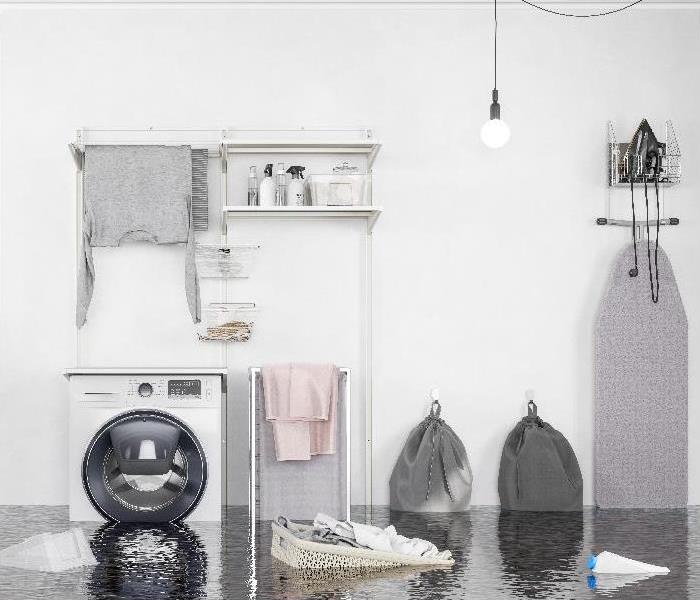How Do I Restore Flooding During a Power Outage in Chicago?
6/19/2020 (Permalink)
SERVPRO Flood Damage Restoration Services Are Available for Residential Flooding in Chicago
Why do floods lead to power outages?
Last month was the wettest since records began in Chicago. Heavy and persistent rainfall can cause rivers to rise uncontrollably. Once water overflows unto roads, it can buildup speed resulting in flash flooding. As little as two feet of moving water can carry away most vehicles. The water current is powerful enough to break electrical wires above and below ground, which can lead to power outages. It can be exceptionally challenging to repair a flooded property without the requisite power or lighting. At SERVPRO, we stock our trucks with portable generators as well as string, stand, and wobble lighting to assist us in the urgent task of mitigating water losses in residential and commercial properties.
How do you remove floodwater during a power outage?
When flood damage strikes Chicago, it often brings with it power outages across residential communities. The first few days of restoration are crucial to returning a home to its preloss condition, which can seem impossible without the necessary power supply. SERVPRO technicians can deploy portable generators with a run-time of up to twelve hours for residents with floodwater intrusion. These generators are enough to provide the basics of lighting and pumping equipment with a run-time of twelve hours. In properties with major ground floor flooding, we can use industrial generators that run for twice as long as portable generators and provide sufficient energy for the entire property.
What are the crucial early stages of flood recovery?
• Reducing standing water levels
• Securing the property from further water intrusion
• Sealing broken parts of the property to prevent trespass
Are flooded properties dangerous?
Environments with massive quantities of floodwater can have an impact on your health and your safety. Water contamination is among the most well-known dangers of flooding; however, there may be many hazards in a flooded building. SERVPRO technicians can scope property to assess any potential dangers before entering the site to begin work. We are usually testing for electrical hazards, possible structural collapse as well as debris during a scoping task. Sometimes if there is electrical equipment running in the presence of water, the consequences can be lethal. Restorers mitigate losses at a site while also preparing for safe entry for other specialist repair companies.
How can you test for electrical hazards?
Even during power outages, there is a risk of wires becoming live or power surges that may endanger restorers. We use a non-contact voltage detector to assess whether there is a live current in materials, circuits, or standing water. We run our water restoration equipment through portable ground fault circuit interrupters (GFCI). GFCIs protect electrical equipment from water. It is not uncommon for wires to run through the water when restoring a flooded property, which is why GFCIs are an essential tool during the mitigation procedure. There may be situations where our technicians are running various types of equipment through a single generator. To prevent fusing, our teams calculate equipment usage then run a circuit analyzer to maintain equipment usage below 80% of the full power supply as recommended by National Electric Code (NEC).
What tools should you use in restoration?
• Carpet removal tools like knee kickers and razor knives
• Screwdrivers, wrench, flashlight, and a stapler
• Hammers, pry bars and rubber hammers
• Plumbing equipment
Is the exterior of my home included with flood restoration?
When flash flooding reaches your property, it brings with it, silt, grime, and debris. Often, the exterior of your home may be significantly dirty and can contain hazardous waste substances. To remove these massive amounts of trash, SERVPRO technicians can use a power washer. Coldwater powerwashers deliver high-pressure water directly onto a surface to loosen bonded soils. We can also run detergents and cleaning agents through the power washer to aid in the cleaning process. Power washers can also be useful for vehicle cleaning or in garage spaces and basements without drywall or insulation.
Is dehumidification the best method for drying a property?
While dehumidification can be a crucial part of the drying strategy, it is not the only part. Dehumidifiers can be inefficient in situations where flooding affects the entire property and require twenty or thirty units to impact the residual moisture. When flash flooding affects the whole first floor of a structure, our technicians opt for indirect fired furnaces—these equipment heat dry outdoor air before blasting it into the property through a duct. Our technicians measure the humidity of the exhausted air to assess how effective the drying method is when using fired furnaces.
Rainwater flooding can be a challenging experience for homeowners. Contact SERVPRO of Hyde Park / E. Bridgeport / Bronzeville (312) 509-5000.

 24/7 Emergency Service
24/7 Emergency Service